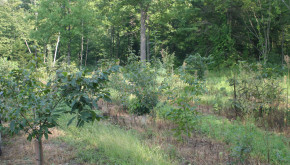
Guest Post by Robin Putzrath, PA landowner
After the Tennessee Gas pipeline that crosses our property was expanded a couple of years ago, we were left with a deforested 100 foot temporary work space along the pipeline right of way. Our plan was to plant the same species of trees already growing in the area, in the hopes that eventually it would look like nothing had happened. However, while attending a forestry seminar, my husband and I spoke with a forester who changed our minds. More specifically, he mentioned how this was a good opportunity for us to introduce diversity into our environment. Rather than planting more of the same, adding diversity could provide habitat for different species and additional resources for our resident wildlife. This was a very appealing idea to us.
With this new thinking, we started researching the concept of forest diversity, so we could consider which options would work best for us. About this time, I met a woman with The American Chestnut Foundation, who mentioned that the Tennessee Gas pipeline was giving them a grant for an early successional habitat restoration project. The project was to align with the Migratory Bird Treaty Act. The US Fish and Wildlife Service was especially interested in attracting golden-winged warblers, endangered songbirds that have been seen in NE Pennsylvania and require an early succession forest habitat for nesting.
As a result, we now are working with these organizations to plant American chestnuts this spring along our pipeline right of way. These trees will grow to about 15 feet before they are knocked down by blight, after which they will re-sprout and start the cycle again, creating a permanent early successional forest at the interface of the right of way and our mature forest. Hopefully golden-winged warblers will find this irresistible. When they get old enough, regardless of their height at the time, the trees will start producing chestnuts, which we know will be appreciated by many of the animals populating the area.

